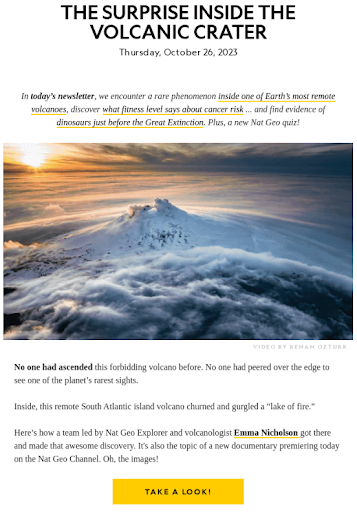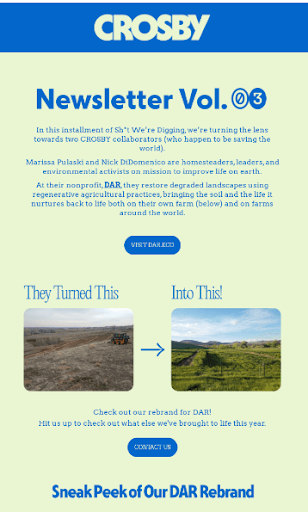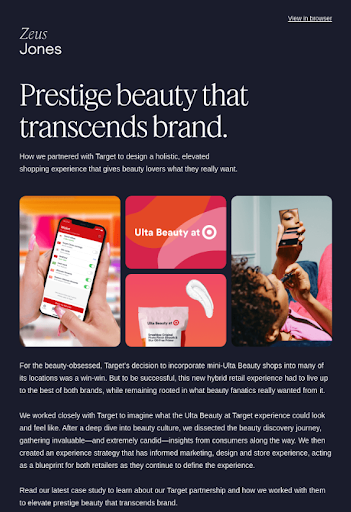
Let’s face it: Customers can be a fickle bunch. Competition for customer loyalty is tough, and there’s always something new and shiny to distract them.
So, how do you keep your customers faithful? You stay faithful — with a regular email marketing newsletter.
A monthly newsletter is just what it sounds like — an email that informs subscribers of news about your organization or shared interests. It’s a great way to generate a devoted following with your audience. Sending a monthly newsletter helps develop stronger connections with your subscribers, increase sales, and drive more traffic to your website.
Publishing a monthly newsletter is among the best tools for increasing subscriber engagement. If your time allows — and you have enough relevant information to share — you can write a weekly newsletter. You can also consider a quarterly newsletter if it’s more appropriate for your business model.
Creating an engaging monthly newsletter
To make the most of your newsletter emails, consider these factors.
Five elements of a monthly newsletter
There are several key aspects that your monthly newsletter should include.
- A clear and compelling subject line: Your newsletter’s subject line is usually the first thing people see. Writing a compelling subject line that captures people’s attention is crucial. The more compelling your subject line is, the more likely they will read your email.
- An interesting preheader: Your email’s preheader is a blurb that appears after your sender’s name and subject line. It summarizes the content of your message so readers know what to expect if they open it.
- A beautiful newsletter design: An appealing newsletter has a clear format and is easy to follow. You can experiment with various monthly newsletter templates, color designs, fonts, graphics, and other elements to find a layout that fits your business.
- Relevant content for your audience: Your newsletter should contain information pertinent to your subscribers’ interests. Include topics that appeal to their wants or needs and align with your organization’s business model.
- A call to action (CTA): A CTA encourages readers to take some form of action. The action might be visiting your website, purchasing, booking an appointment, offering feedback, or some other activity. Make sure your readers can easily spot your CTA and that it’s easy to follow.
Generating high-quality, targeted content
Creating compelling content starts with defining your newsletter’s purpose. What do you want to accomplish with it? Do you want to build anticipation in your company’s products and services, or are you sharing information that fits your audience’s interests?
Once you know your newsletter’s purpose, you can create content that aligns with it. Some examples of content you might include are news about your company, upcoming industry events, new product features and reviews, educational information, and other relevant details.
Designing a user-friendly newsletter interface
Your newsletter interface should be easy to interact with, meaning its format is clear and straightforward to follow. Include your company’s logo, clear images, and headings to separate different sections of your newsletter. Your CTA should grab the reader’s eye and include specific directions so they can act on it if they want to.
Drafting and finalizing subject lines for high click-through rates
The subject line is the first thing readers judge in your newsletter, so create one that grabs their attention. Some of the best subject lines encourage a sense of urgency and curiosity among readers. For instance, you might inspire subscribers to open your newsletter using terms like “important” or “act now.”
Personalizing your newsletter’s subject line is also an excellent way to inspire the recipient to open the email. You might personalize your newsletter by including the recipient’s name or other identifying details.
It’s a good idea to draft several subject lines. You can test them among a small segment of your subscriber base to see which ones generate the highest open rates, then use the leading performer as your final subject line.
Choosing the right newsletter design
Your newsletter’s design is one of its most essential components. Select a design with a simplistic interface that’s easy to follow no matter what device you view it on — a smartphone, tablet, or computer. If your newsletter contains multiple sections, use headers and body text to separate each segment.
Deciding what type of content to include
The content you include in your newsletter should reflect its purpose. If you aim to keep subscribers informed of organizational updates, include them in your content. If your newsletter is product or service-oriented, share clips of your newest items or feature offers. Educational or interest-related newsletters may incorporate blogs or articles relevant to subscribers’ needs.
Using wireframes and design elements to collaborate on the design
Wireframes form the basic structure of your newsletter. They include a header section, logo, menu, and body content. Design elements help distinguish each part of the newsletter, such as its layout, navigation bars, and interactive buttons or links.
You can design a wireframe or use a pre-designed monthly newsletter template. Constant Contact’s email marketing tools include a variety of wireframe designs you can choose from to create your newsletter.
Scheduling and deploying the newsletter for optimal engagement
Sending your newsletter at an optimal time — when subscribers are most likely to check their inbox and open your email — can improve open and read rates. You can determine the best time to send with the help of your email analytics tools, which will indicate when people are most likely to read your communications. Some email marketing tools will recommend optimal sending times based on prior sent messages.
Planning and production process
To create an effective newsletter, adopt a thorough planning process:
1. Gather ideas
Schedule time to develop the content strategy for each newsletter you produce. Use the time to identify what you want to share with your subscribers and what you hope to gain from your message. Outline each topic you’ll cover in your newsletter. Your email will likely include a range of topics, from product descriptions to blog snippets to company happenings. Think about the most important updates to keep subscribers informed. After, define your CTA — whether that’s promoting customer loyalty, directing subscribers to visit your website, or making a purchase.
2. Establish comprehensive planning strategies
A comprehensive newsletter planning strategy goes beyond idea generation and sets the stage for your short and long-term email marketing newsletter goals. It assesses how often you’ll send subscribers a newsletter, your objectives, and how to measure the results.
3. Use efficient production techniques
Once you understand the goals and purpose of your newsletter, you can establish a production routine. Your newsletter’s production includes the templates or wireframes you’ll use for your emails, sending consistency, and how you’ll create your content. Other aspects of production include any consistent graphics or images you’ll use — like your company’s logo — and user interface/user experience (UI/UX) design.
4. Test protocols
Before sending your newsletter en masse, it’s good practice to do some initial testing among a small portion of your subscribers. You can change various elements of your newsletter, like your subject lines, CTAs, and images, to see which combination generates the best results among your testing base.
Aside from A/B testing, thoroughly reviewing your content is a good idea. Check for spelling and grammatical errors and make sure all links and other user elements function correctly.
5. Curate your content
Creating a steady flow of content for your monthly newsletter can be time-consuming, especially if you have many other tasks. If you’re creating content yourself, schedule a time to devote to content curation.
There are a couple of ways you can cut down on your work while still achieving results:
- Share existing content: Your newsletter doesn’t have to consist entirely of new content. You can use pre-existing content from blog posts, infographics, news, press releases, and other sources to fill out the bulk of your newsletter.
- Use pre-designed templates: Some email marketing platforms include pre-designed templates with sample text you can use for inspiration. The sample text is helpful for subject lines, short blurbs, and other brief messaging.
Measuring success and continuous improvement
You’ll want to use analytics and metrics to evaluate your newsletter’s performance. Analytics and metrics will show your newsletter’s success over time and help you understand where your campaign is succeeding and where improvements may be necessary.
A few metrics to monitor include the following:
- Click-through rate: Your click-through rate represents the percentage of email recipients who clicked on your links. It helps you understand how subscribers engage with your newsletter.
- Open rate: Your open rate is the percentage of subscribers who open your email. It tells you how many recipients open your message. However, it can be a little misleading since some email service providers only report an opened message if the images are fully downloaded.
Read now: How Apple’s Mail Privacy Protection Impacts Email Marketing
- Conversion rate: Depending on your newsletter’s purpose, you may want readers to take a specific action. You can use the conversion rate to track how many recipients take that action.
- Bounce rate: Your bounce rate includes both hard and soft bounces. A hard bounce indicates that your emails go undelivered, while a soft bounce indicates a temporary delivery problem. Keeping a low bounce rate is essential to maintain your email sender score.
While these are some of the most common newsletter performance metrics, you can establish other benchmarks to monitor newsletter performance.
Past campaign performance can inform future newsletters
As you embark on your newsletter campaign, store your analytics to compare performance over time. Regular campaign evaluation can help you baseline your newsletter expectations and identify areas where improvements may be necessary.
Common mistakes to avoid in email newsletter creation
There are a few typical pitfalls to consider when developing your newsletter. They include:
- Not providing content your subscribers want to read
- Sending newsletters too frequently
- Failing to have a distinct CTA
- Using boring subject lines
- Not reviewing your newsletter’s content and interactive elements before sending
- Disregarding feedback from subscribers
- Using non-responsive templates that don’t display on all types of devices
Be sure to follow proper newsletter development protocols to avoid errors.
Inspiration and examples
Looking for monthly newsletter ideas? Take a look at these monthly newsletter examples from top brands.
1. National Geographic

2. CROSBY Studios

3. Zeus Jones

Technical aspects and tools
A well-crafted newsletter requires practical tools. While you can certainly craft a newsletter within your email service provider’s messaging system, you’ll get professional results from a dedicated email marketing service like Constant Contact.
Through Constant Contact, you can design well-crafted newsletters with pre-designed templates. We offer many email marketing services, including subscriber management, automatic delivery pathways, robust analytics, and a mobile app so you can work on your newsletter from mobile devices.
Keep in mind that tracking your newsletter campaign’s performance is crucial. Monitor your analytics and set benchmarks to evaluate the success of your campaign.
Extra tips
Here are a few additional tips to consider as you develop your newsletter strategy.
How to effectively manage your email list for a monthly newsletter
Your email list contains all the addresses of people who subscribe to your newsletter. Regularly assess it for hard and soft bounces and inactive subscribers, and remove them — especially hard bounces — when necessary. Keeping your bounce rates low will help you maintain a strong sender score.
How often should you send your newsletter for maximum engagement?
The sending frequency of your newsletter can be weekly, monthly, quarterly, or any other timeframe. Once you determine the right frequency for your organization, it’s essential to stick with it. Choose a frequency that allows you to provide quality content without being overbearing.
How do you ensure effectiveness in reaching the target audience?
Building a subscriber base of people who want to read your emails is vital. Avoid purchasing bulk email lists or sending unsolicited newsletters. Instead, grow your email list organically and receive recipient consent before sending your newsletter.
Email subject line strategies that sell
Captivating monthly newsletter subject lines makes the difference between an opened and unopened newsletter. Consider recipients’ needs when designing your subject line if your newsletter is sales-focused. Choose a subject line you think will attract them. For instance, you might highlight your brand-new product or a one-time deal in the email’s subject line.
Monthly newsletters: a great way to build customer connections
Your monthly newsletter can help strengthen customer relationships, boost sales, and increase website traffic. Start by determining your newsletter’s purpose and planning your content strategy. Use practical email marketing tools — like Constant Contact — to manage your subscriber list and create professional newsletters that are appealing to read.
To learn more about email marketing newsletters, check out some of our additional resources:




